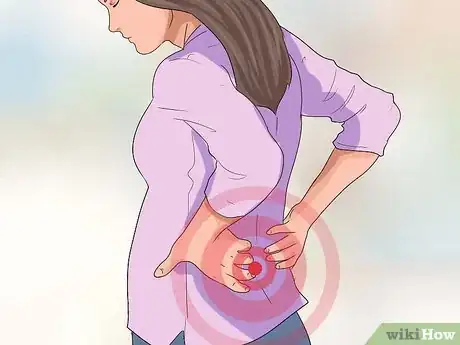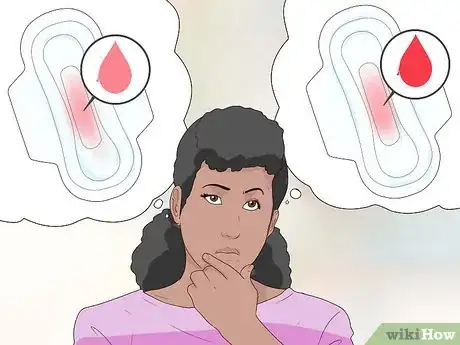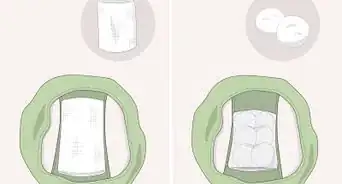This article was medically reviewed by Lacy Windham, MD. Lacy Windham, MD, is a Board-Certified Obstetrician & Gynecologist in Cleveland, Tennessee. Dr. Windham attended medical school at the University of Tennessee Health Science Center in Memphis. Her residency was completed at Eastern Virginia Medical School in Norfolk, Virginia. She was the recipient of multiple awards during her residency training, including Most Outstanding Resident in Maternal Fetal Medicine, Most Outstanding Resident in Oncology, Most Outstanding Resident Overall, and Special Award in Minimally Invasive Surgery.
There are 12 references cited in this article, which can be found at the bottom of the page.
wikiHow marks an article as reader-approved once it receives enough positive feedback. This article received 17 testimonials and 86% of readers who voted found it helpful, earning it our reader-approved status.
This article has been viewed 1,065,660 times.
Premenstrual syndrome (PMS) is a set of physical and psychological symptoms that occur a few days to a few weeks before your period. Implantation symptoms, on the other hand, appear due to the implantation of a fertilized egg in your womb, meaning you are pregnant. Both PMS and implantation can happen around the same time in your menstrual cycle, so it can be difficult to tell the difference between them. However, there are a few differences in symptoms if you pay careful attention.
Steps
Noticing Signs of Implantation and Early Pregnancy
-
1Check for spotting. If you aren't about to have your period, spotting may be a sign of implantation. Normally, this spotting will not be like a regular period; you will just have light bleeding. It may closely resemble the first couple of days of your period.[1]
-
2Be mindful of cramps. Cramps can occur with early pregnancy. While you're likely to feel cramps while on your period they can occur just before your period and are a common symptom of PMS. Implantation pain resembles menstrual cramps.[2]
- Pay attention to how heavy the cramps are. If they are especially painful, you should call a doctor. Also, if they are moved over to one side in your body, you should also call. Both of these could be signs of a problem.[3]
Advertisement -
3
-
4Watch for dizziness. If you are pregnant, you may feel lightheaded or dizzy, most likely because of hormonal changes. However, some doctors think this symptom could also be due to the fact that your body is creating more blood for the baby.[6]
-
5Look for an increase in hunger. Sometimes, even in early pregnancy, you may start to feel more hungry than normal. If the symptom lasts more than day or two, it could be a sign your fertilized egg has implanted.[7]
-
6Check for nausea. Morning sickness is a misnomer; nausea and vomiting can happen any time of the day when you're pregnant. This symptom can happen as early as 2 weeks after you conceive.[8]
-
7Notice food and smell aversions. One symptom of early pregnancy is a sudden aversion to certain foods and smells. This symptom can trigger morning sickness, even if the smells or food were something you loved before.[9]
-
8Watch for trouble breathing. This symptom happens most often early in pregnancy and late in pregnancy. You may feel out of breath more easily. No matter when you feel it, you should definitely talk to your doctor about it.[10]
-
9Notice a metallic taste. Some women may have a metallic taste in their mouth soon after getting pregnant. This symptom is not associated with PMS.[11]
Understanding Premenstrual Syndrome Symptoms
-
1Check for backaches. You certainly can and likely will have backaches later in pregnancy. However, if you are trying to differentiate between early pregnancy and PMS, backaches early on are more likely a symptom of PMS.[12]
-
2Notice your emotional state. Though both pregnancy and PMS can cause mood swings, PMS is more likely to be associated with depression. If you are feeling somewhat depressed, that could be a sign you've not implanted.[13]
-
3Watch for bloating. Though you can feel bloated at the beginning of pregnancy, this symptom is more often associated with PMS. Your stomach may feel extra tight with this symptom.[14]
-
4Look for your period. While this step may seem obvious, it's one of the most significant signs that you're not pregnant.[15] Try to keep track of when you have your periods by marking them on a calendar, so you know when one should be coming up. That way, you'll know you may be pregnant if you've skipped one.
-
5Consider taking a home pregnancy test to get a definitive answer. The most effective method to know if you are pregnant or are simply experiencing PMS is to do a home pregnancy test. These kits are easily available at the pharmacy and come with easy-to-follow instructions.[16]
- You can take a pregnancy test a couple of days before you normally have your period or when you are trying to decide whether you are having PMS or implantation symptoms. Some pregnancy tests claim they can be accurate that early. However, for a more definitive result, wait until a week after you would normally have your period.[17]
- Most times a blood test will detect hormone only a couple of days prior to the early home pregnancy tests. Don't request a blood test just for curiosity, as your insurance is not going to cover that.[18]
Recognizing Similar Symptoms of Both Conditions
-
1Know the difference between implantation bleeding and period bleeding. You know what your normal period is like. Whether it's heavy or light, you know what to expect from your period. Implantation bleeding should be lighter than your period, though, because you're not shedding the whole lining of your uterus, plus it usually won't last as long as your period. Implantation spotting normally occurs before the expected period.[19] You should only see a few spots of blood, plus it will be lighter in color, usually pink or brown, as opposed to the bright red of period blood.[20]
-
2
-
3
-
4Look for tiredness. Both PMS and implantation can cause you to feel extra tired. When you become pregnant, you can feel this symptom as early as one week in, most likely because of an uptake in progesterone.[25] However, PMS can also make you feel fatigued as well, also likely due to hormonal changes.[26]
-
5
-
6
-
7
-
8Understand when symptoms may appear. Usually, PMS symptoms will occur 1 to 2 weeks before you start your period.[33] They usually disappear within a couple of days of starting your period.[34] Implantation symptoms and early pregnancy symptoms generally occur around the same time; it's at the same point in the cycle that you either implant or shed the lining of your uterus and start your period.[35]
Warnings
- If your symptoms persist, visit a doctor to be absolutely sure.⧼thumbs_response⧽
References
- ↑ https://www.nichd.nih.gov/health/topics/pregnancy/conditioninfo/Pages/signs.aspx
- ↑ http://my.clevelandclinic.org/health/diseases_conditions/hic_Am_I_Pregnant
- ↑ http://my.clevelandclinic.org/health/diseases_conditions/hic_Am_I_Pregnant
- ↑ http://www.nlm.nih.gov/medlineplus/ency/patientinstructions/000583.htm
- ↑ https://www.nichd.nih.gov/health/topics/pregnancy/conditioninfo/Pages/signs.aspx
- ↑ http://my.clevelandclinic.org/health/diseases_conditions/hic_Am_I_Pregnant
- ↑ http://my.clevelandclinic.org/health/diseases_conditions/hic_Am_I_Pregnant
- ↑ https://www.nichd.nih.gov/health/topics/pregnancy/conditioninfo/Pages/signs.aspx
- ↑ http://www.mayoclinic.org/healthy-lifestyle/getting-pregnant/in-depth/symptoms-of-pregnancy/art-20043853
- ↑ http://www.nlm.nih.gov/medlineplus/ency/patientinstructions/000583.htm
- ↑ http://my.clevelandclinic.org/health/diseases_conditions/hic_Am_I_Pregnant
- ↑ http://www.womenshealth.gov/publications/our-publications/fact-sheet/premenstrual-syndrome.html
- ↑ http://www.womenshealth.gov/publications/our-publications/fact-sheet/premenstrual-syndrome.html
- ↑ http://www.nlm.nih.gov/medlineplus/ency/article/001505.htm
- ↑ http://my.clevelandclinic.org/health/diseases_conditions/hic_Am_I_Pregnant
- ↑ http://www.mayoclinic.org/healthy-lifestyle/getting-pregnant/in-depth/home-pregnancy-tests/art-20047940
- ↑ http://www.mayoclinic.org/healthy-lifestyle/getting-pregnant/in-depth/home-pregnancy-tests/art-20047940
- ↑ http://www.mayoclinic.org/healthy-lifestyle/getting-pregnant/in-depth/home-pregnancy-tests/art-20047940
- ↑ http://www.mayoclinic.org/healthy-lifestyle/pregnancy-week-by-week/expert-answers/implantation-bleeding/faq-20058257
- ↑ http://www.webmd.com/baby/guide/implantation-bleeding-pregnancy
- ↑ https://www.nichd.nih.gov/health/topics/pregnancy/conditioninfo/Pages/signs.aspx
- ↑ http://www.mayoclinic.org/diseases-conditions/premenstrual-syndrome/basics/symptoms/con-20020003
- ↑ http://www.womenshealth.gov/publications/our-publications/fact-sheet/premenstrual-syndrome.html
- ↑ http://www.mayoclinic.org/healthy-lifestyle/getting-pregnant/in-depth/symptoms-of-pregnancy/art-20043853
- ↑ https://www.nichd.nih.gov/health/topics/pregnancy/conditioninfo/Pages/signs.aspx
- ↑ http://www.mayoclinic.org/diseases-conditions/premenstrual-syndrome/basics/symptoms/con-20020003
- ↑ https://www.nichd.nih.gov/health/topics/pregnancy/conditioninfo/Pages/signs.aspx
- ↑ http://www.womenshealth.gov/publications/our-publications/fact-sheet/premenstrual-syndrome.html
- ↑ http://www.nlm.nih.gov/medlineplus/ency/article/001505.htm
- ↑ http://www.mayoclinic.org/healthy-lifestyle/getting-pregnant/in-depth/symptoms-of-pregnancy/art-20043853
- ↑ http://www.nlm.nih.gov/medlineplus/ency/article/001505.htm
- ↑ http://www.nlm.nih.gov/medlineplus/ency/patientinstructions/000583.htm
- ↑ http://www.womenshealth.gov/publications/our-publications/fact-sheet/premenstrual-syndrome.html
- ↑ http://www.nlm.nih.gov/medlineplus/ency/article/001505.htm
- ↑ http://www.womenshealth.gov/publications/our-publications/fact-sheet/menstruation.html#b
About This Article
Implantation and PMS symptoms usually occur around the same time, but there are many symptoms that are unique to implantation. If your bleeding is lighter than normal and goes away quicker, this is probably implantation bleeding. Early signs of pregnancy include increased urination and hunger, feeling dizzy, nauseous, or out of breath. You might experience these symptoms at the same time as moodiness, tiredness, headaches, and cravings, which are common to both PMS and implantation. If you think you might be pregnant, take a home pregnancy test to find out. For more tips from our Medical co-author, including how to notice if you miss a period, read on.





















































































Medical Disclaimer
The content of this article is not intended to be a substitute for professional medical advice, examination, diagnosis, or treatment. You should always contact your doctor or other qualified healthcare professional before starting, changing, or stopping any kind of health treatment.
Read More...